The worst thing about having a hobby that is an outdoor activity is that for most regions there will be entire seasons that you have to go without your favorite pastime (unless your hobby is snowmobiling and ice fishing).
Typically the winter is the worst part of the year for those who like to spend a bit of time outside. This is especially true for those that want to kayak year-round and have to contend with icy, dangerously cold rivers and rapids.
While a big portion of kayakers will go out on the water throughout the year, there are precautions you should take. The dangers of kayaking in the cold are not to be underestimated and lack of preparation could prove to be fatal if you capsize.
To help keep you safe in frigid waters and to make sure you can safely do what you love all year round, this article will go into great detail about how to comfortably kayak in the colder months.
What to Wear
Anyone who has spent time in colder regions of the globe knows the golden rule, cover your hands, head, and feet. These are the three places where you will lose heat the quickest and it doesn’t matter how cozy your shoulders and chest are. If your exposed head is catching a gust of winter’s chill then you are going to be miserable.
This is due to the lack of protective insulation in our head, feet, and hands, which is different from the rest of our bodies. The middle section of our body is high in fat, which doubles as a natural jacket, unlike our exposed extremities.
So when we go kayaking in the fall and winter months, not only do we need to cover up our body but we should make sure to pay special attention to our most vulnerable parts.
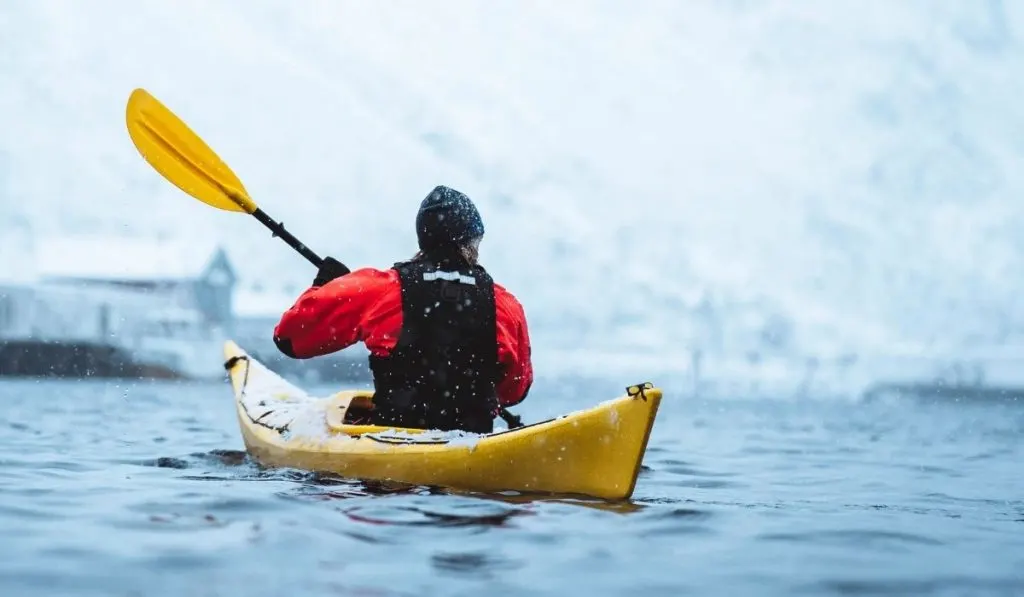
Warm Hat
This is especially true for those that keep their hair short but is a universal rule for anyone on the water. You are going to want to get something that is comfortable, warm, and definitely water-resistant. Wool beanies are great if you need to find something quick and cheap as they can be purchased in most retail stores for a fairly reasonable price tag.
If you have a bit more time to prepare you can venture for a neoprene cap which will keep your head warm even if the unfortunate happens and you end up in the water.
The fabric used in these caps is specially designed to ensure that your cranium retains its heat even in the untimely circumstance that it is dowsed in water.
These caps may run a bit higher in price than a wool beanie, but you can still manage a quality cap for around thirty dollars.
If you are one of those die-hards that wear shorts in the dead of winter, then you may want to venture into lighter territory with a face cover and ballcap. Some people run unbelievably warm and with the already dense layers of clothing you will be wearing, a wool beanie can feel like too much.
With this skimpier alternative you have the option of lowering your face cover or removing your cap if you start to heat up.
If it is your first time kayaking in the winter, you may want to bring a backup beanie or cap in case your ball cap proves too light in coverage. Best to be overly prepared than miles away from any sort of warmth with nothing but a Cubs hat on.
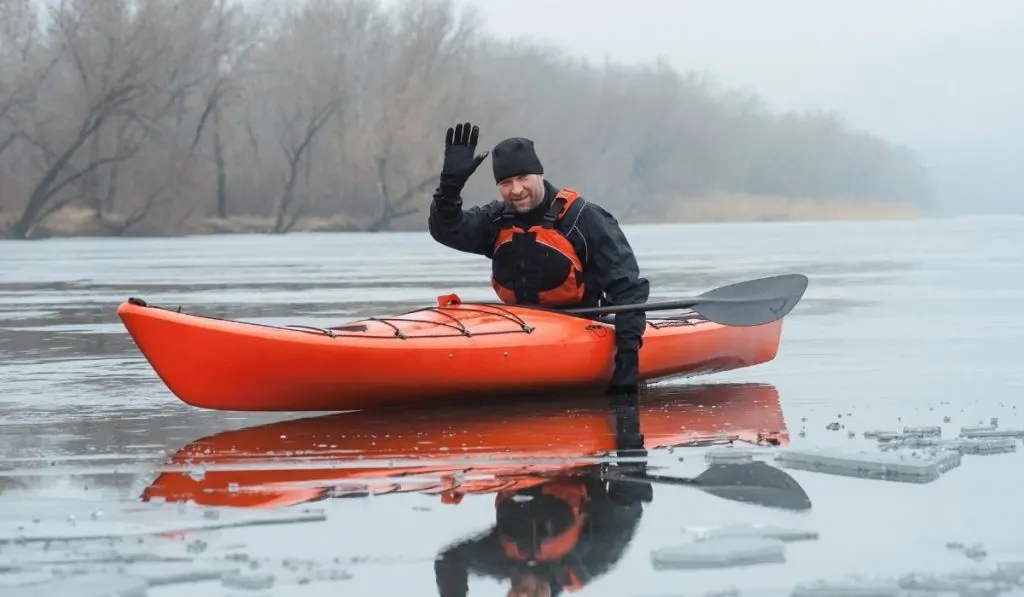
Proper Gloves
When looking to keep your hands warm, you want to find a good balance of warmth while also maintaining your ability to keep your fingers nimble. The amount of times in the winter I have had to remove a mitten for the most minor of tasks is nothing short of maddening.
So while I will recommend things based on their protection from the elements, keep in mind that you will need to think of your ability to use your fingers as well when out on the water.
Kayaking mittens are going to give you the best insulation possible and keeping your fingers pressed together will offer added body heat to an already sufficient piece of equipment. The problem comes in when you have to do something that requires the use of your fingers and not your weird new arm paddle you call a hand.
So if you are someone who is prone to frozen fingers, these may be the choice for you as long as you can accept that they may have to be removed every now and then.
If you are looking for something that allows your hand to have a bit more freedom, you can look for kayaking gloves or gloves that are made with neoprene. The thicker the material you use the warmer these will be while also allowing you to have the freedom to use your fingers. They will also improve your ability to hold onto your paddle, offering a bit of clutch for your grip.
Pogies are a great option as well that actually allow you to wear gloves inside of them. These helpful hand huggers are always on your paddle and allow your mitts a cozy, neoprene knapsack to relax in. You can put your hands in them while rowing to keep your hands warm.
Pogies are spacious enough that, typically, you can wear an additional layer of gloves inside of them if you want to avoid bare hands.
Foot Protection
Even though your feet will be comfortably deposited into the top compartment of the canoe, they are still vulnerable to the elements. To help keep your toes unfrozen, you should look for a pair of wetsuit socks that can be doubled up with a wetsuit shoe. I know we have been really exhausting how helpful neoprene is, but it really is essential to avoid the dangers of cold weather, especially when you are in danger of becoming wet.
Another good option is booties which will not only help keep your feet warm but also give them a bit of traction on slippery surfaces. These come in varying degrees of density, so if it’s especially cold, shoot for a pair that is on the thicker side.
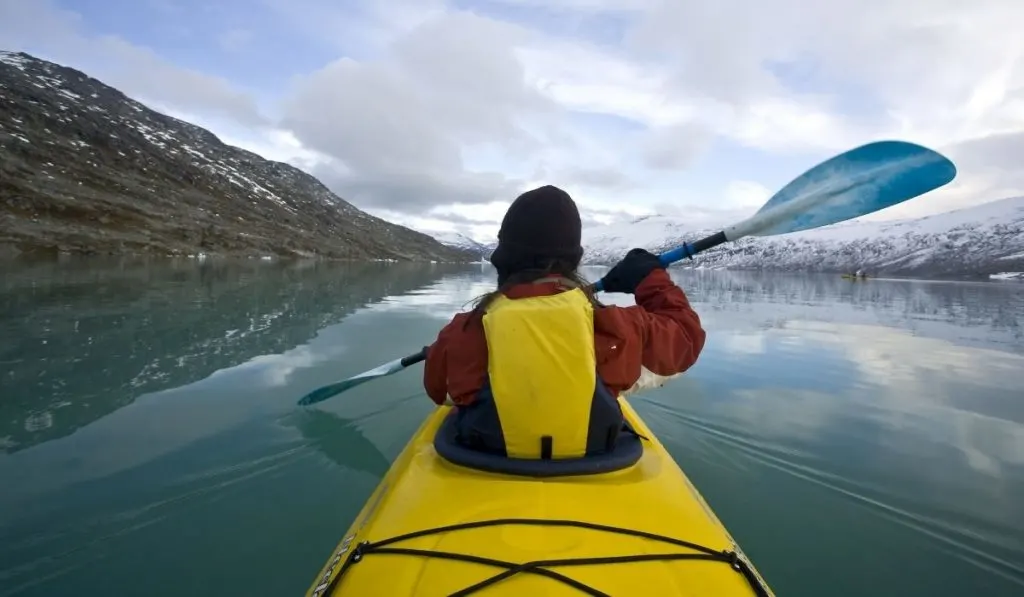
Body Protection
When covering up your mid-section you should take into account that you can’t predict how cold it will feel when you are in the middle of paddling, but you can prepare for it. At the risk of sounding like everyone’s mom during the first winter snow, you should layer up. If you are dripping sweat when you do finally get into the swing of paddling, you can take off a layer or two.
A drysuit is a fantastic option for keeping your body nice and warm, though not it’s not enough by itself. The benefit of a drysuit is that it is easily removable and will keep the other layers underneath of it water-free. You should still look to wear a few layers of non-cotton materials with it to ensure that you are properly fitted for the winter chill.
A thicker wetsuit can also work to keep you warm and dry while kayaking. Typically speaking, you will want to find a wetsuit that is about 6/5 mm if the temperature drops below 43°F. The downside to a wetsuit is it can be cumbersome to take off and on and is also the only thing you will be able to wear as far as layers go.
If you are in desperate need of a bathroom break, peeing in your wetsuit could bring down your internal temperature after a bit of time which could lead to hypothermia.
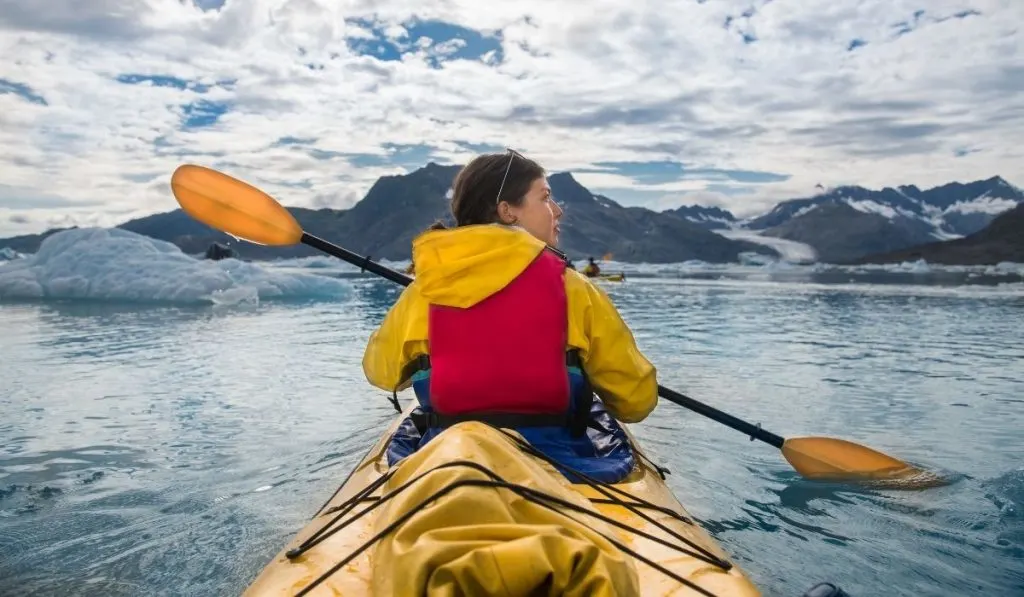
Additional Accessories
There are a few things that you can bring with you on your kayak trips to make sure that you keep warm throughout the experience regardless of what may come up. You should definitely make sure you bring a few changes of clothes, regardless of how waterproof your current outfit is.
Things come up, accidents happen and you never know when a wetsuit will tear or your canoe will take on considerable amounts of water from spray or an unexpected rain shower.
Always bring a personal flotation device regardless of when you are kayaking but especially in the winter. If you find yourself in the water, before you deal with the horrifying reality of hypothermia you will experience what is known as muscle incapacitation. This prevents your muscles from doing the most trivial of tasks and can prove deadly if you are already trying to stay afloat.
Make life a little easier and potentially longer by investing in one of these relatively inexpensive life-saving tools.
You should also seek out a spray skirt that can be equipped for your kayak.
These handy tools attach to your waist or midsection and work as an umbrella for the interior of your kayak, preventing errant water from getting into the depths of your boat.
On top of this, it also has the added benefit of helping to keep your lower extremities snug from the elements.
Tips for Kayaking in the Cold
Outside of what you should put on your body for a chilly outing, you should also be made aware of a few problems winter brings when going out on the water. Colder temperatures have an additional list of issues that can arise than we are used to if we only go out in the summer and spring months.
With these tips, you can be better prepared for any unforeseen circumstance that could arise the next time you kayak in the cold.
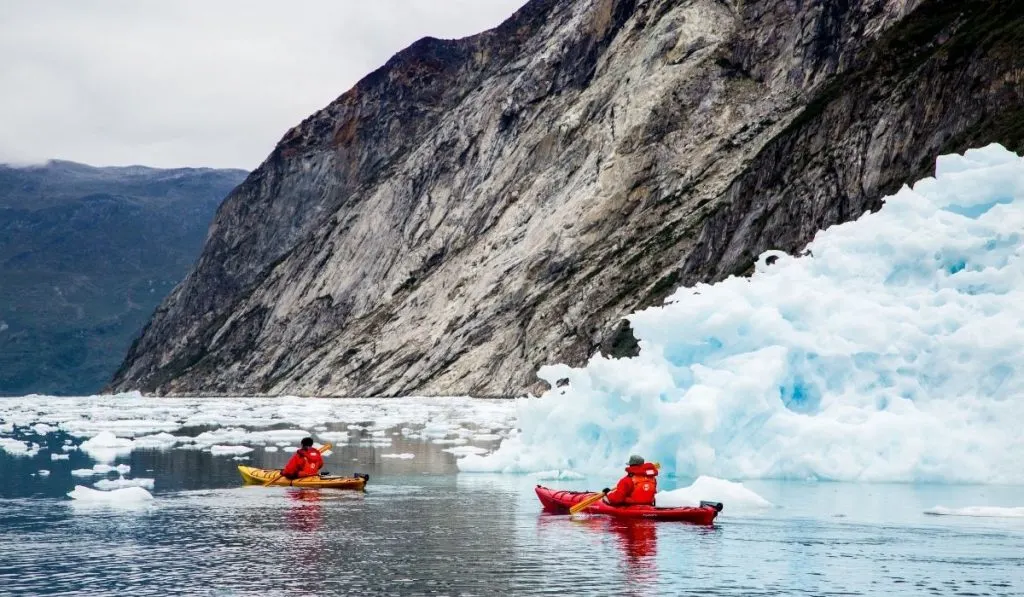
Ice Can Be Very Dangerous
When kayaking in the winter months one of the biggest dangers you will encounter is the ice. Not only can it potentially capsize you or even cause injury to you or your kayak, but it can also prove to be a fatal encounter if you aren’t properly prepared for it. If you notice plates of ice being tossed around by the current, you may want to avoid going out.
Ice can not only trap you underneath it if you capsize, it can also get thrown onto your canoe or even hit you, causing bodily harm.
Don’t Go Alone
This can be true for even the most experienced paddlers out there. The winter months are treacherous and deadly compared to the more forgiving weather of summer. It can be easy to feel that prideful sense of independence and try to conquer the frigid waters on your own, but it can also be easy to go missing when things go wrong.
Having a companion or two with you can not only make the trip more enjoyable but also much safer. If you are injured, if you capsize, if you need an extra hand getting through treacherous parts of your trip, all can be mitigated with the help of a reliable friend. Don’t be proud, make sure when you go you have a person with you to make sure you get home safely.
Bring The Proper Tools
VHF radio, flares, a fully charged phone, a thermos of something hot (non-caffeinated) and a change of clothes are all essential. You should also keep in mind that in winter, the lower temperatures will actually drain a phone battery more quickly than in the summer, so having an alternative way to reach folks is not only wise but recommended. It can be nice to have a cup of coffee with you in a thermos especially if you go out early, but it will actually make you colder over time.
Final Thoughts
If you follow the advice in this article as well as look to more experienced winter kayakers for help, you will no longer have to wait months between trips.
Make sure you bring a friend, proper clothes, and the tools needed, happy ‘yaking!
